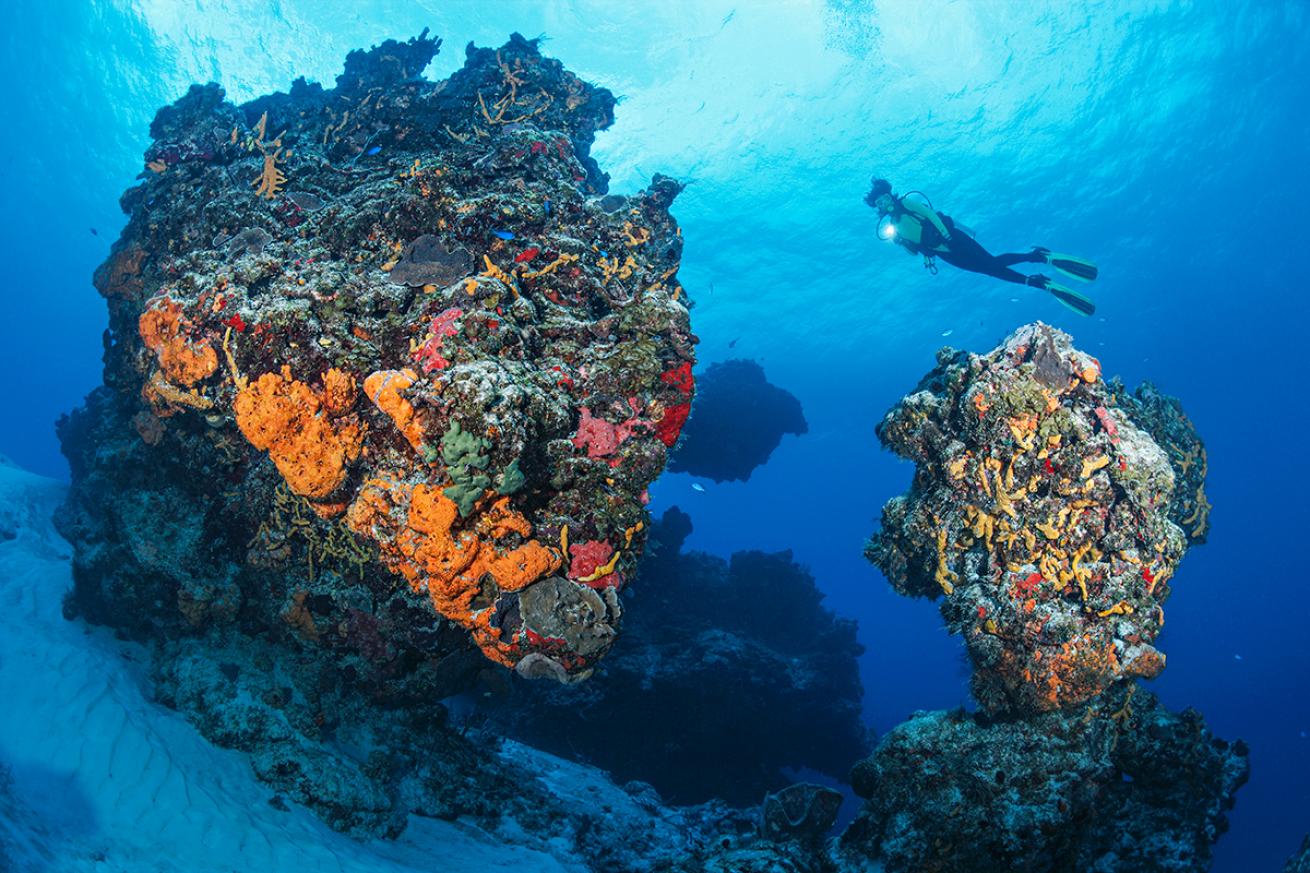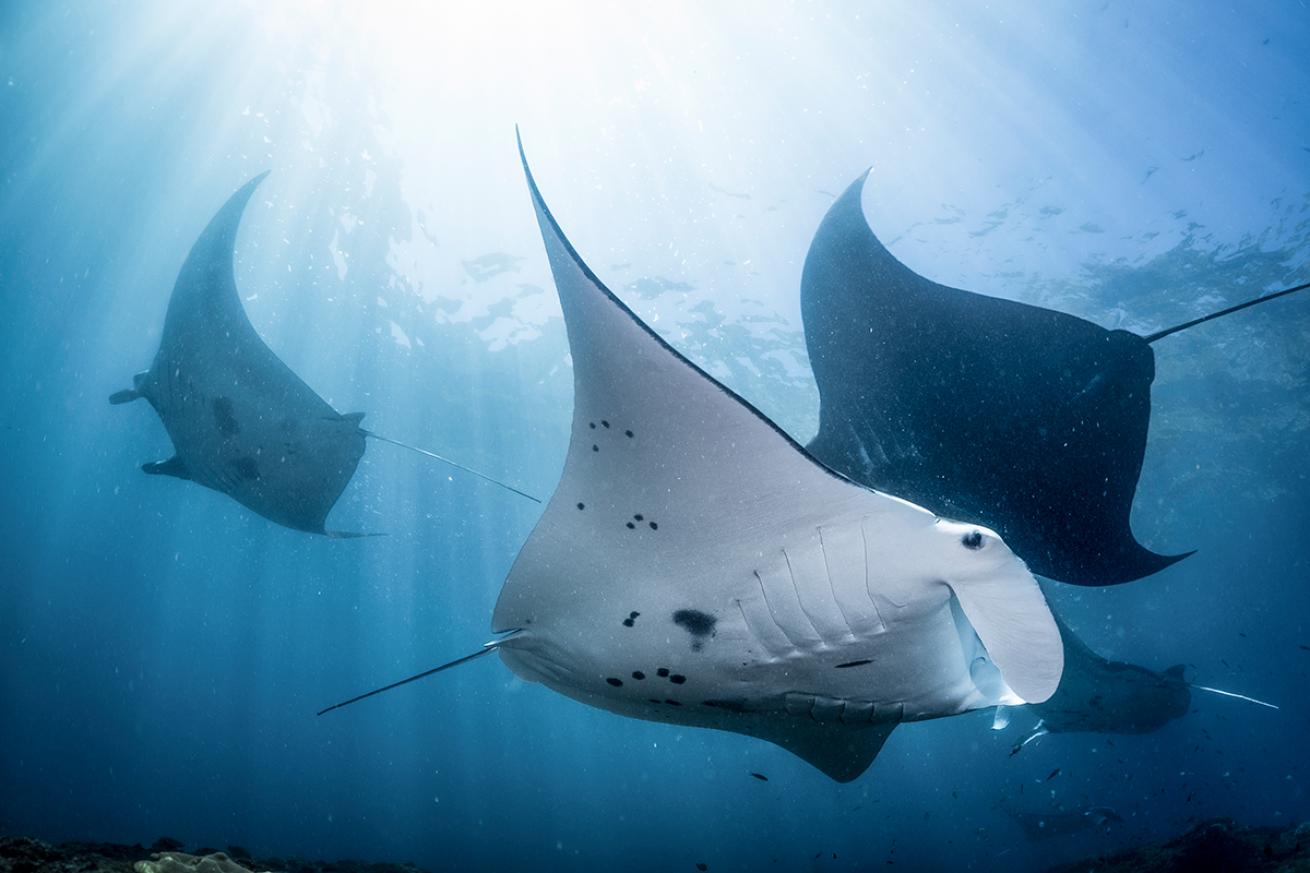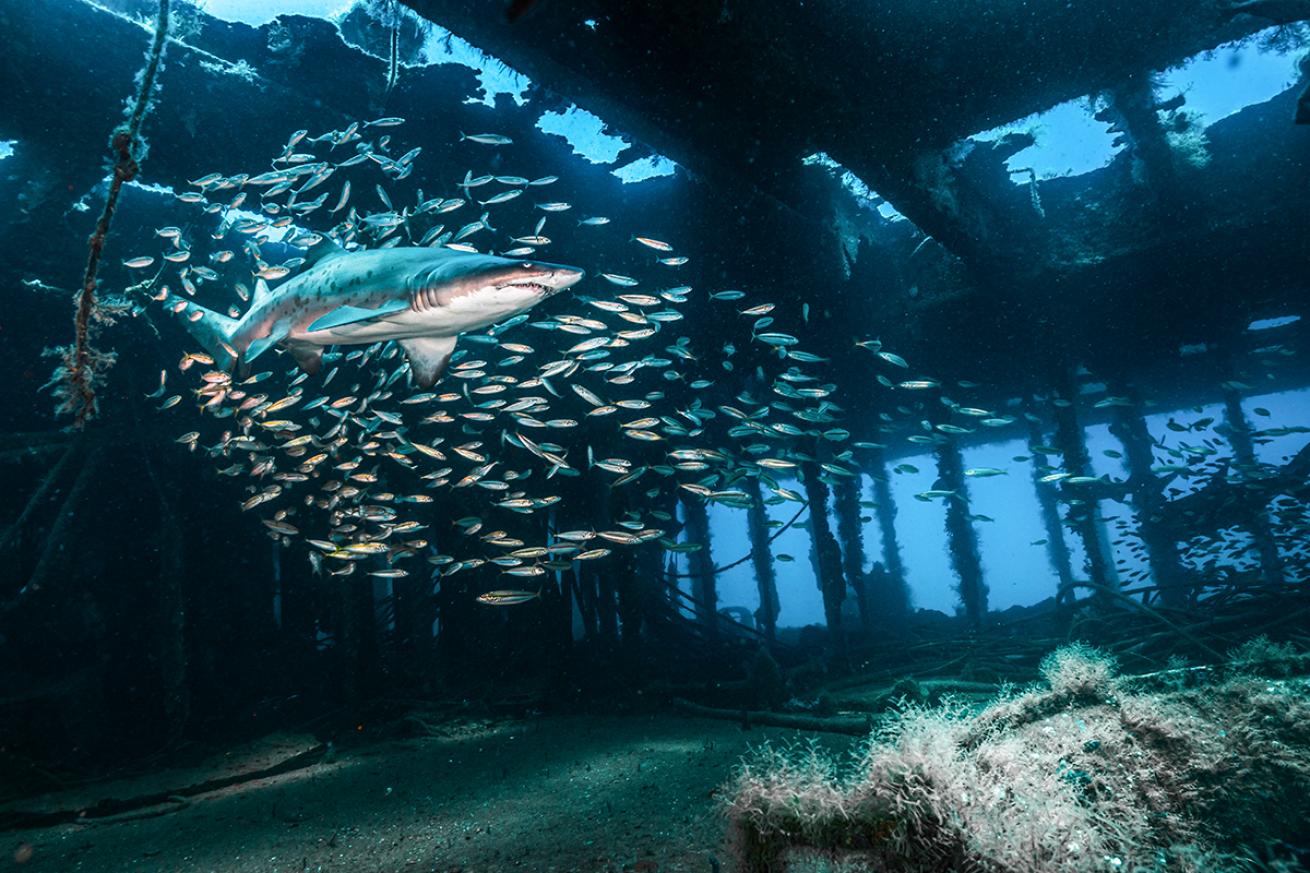The Best Dive Destinations for Advanced Diving
Divers looking for challenging conditions — and the big payoffs they bring — will be delighted with of these destinations, selected at the healthiest marinescapes by nearly 6,000 Scuba Diving magazine readers.
Mexico

Brandon ColeA diver soars above towering reef structures and rainbow-colored sponges in Cozumel, Mexico.
The island of Cozumel, off of Mexico’s Riviera Maya coast, could be considered advanced diving for its currents alone. Every dive off the 34-mile-long island is a drift where boats drop guests into the water at one spot and pick them up at the end of the dive, down-flow.
It could also be considered a challenging destination for its wall dives, which are the majority of sites. But the most intriguing reasons why Cozumel hails as a paradise for experienced divers are reefs at each end of the island—Barracuda to the north, and Maracaibo at the southern end.
Both have strong currents, and their topography can appear to play tricks. “These sites are bottomless,” says Henry Schultz, owner of Salty Endeavors, a dive shop based on island. “By that I mean you will never see the bottom—or if you do, it’s not a good thing.” At 115 feet deep, the Maracaibo wall cuts inward and becomes an overhead environment for divers below that depth. “What makes Maracaibo interesting is that the wall is concave,” Schultz says. This is where you get the bigger animal sightings, including hammerheads, mantas and eagle rays.
These are the sorts of dives that Schultz likes to vet divers for beforehand. Neither is a first-day option for any of his guests.
Readers Picks
Operators
Aldora Divers, Cozumel, Mexico
Cave Training Mexico, Riviera Maya
Cozumel Marine World, Mexico
Dive with Martin, Cozumel, Mexico
Pro Dive International—Mexico, Riviera Maya
Scuba Club Cozumel
Dive Center, Mexico
Scuba Du, Cozumel, Mexico
Resorts
Allegro Cozumel of Barcelo Hotel Group, Mexico
Casa Del Mar, Cozumel, Mexico
Cozumel Hotel & Resort by Wyndham, Mexico
Occidental Cozumel of Barcelo Hotel Group, Cozumel, Mexico
Palace Resort, Cozumel, Mexico
Melia, Cozumel, Mexico
Presidente Intercontinental, Cozumel, Mexico
Scuba Club Cozumel, Mexico
Liveaboards:
Nautilus Explorer, Mexico
Rocio Del Mar, Baja, Mexico
Indonesia

DiveFriday / Shutterstock.comIndonesia’s currents sweep in nutrients, drawing megafauna like manta rays to advanced dive sites.
Depending on how one defines advanced diving, much of Indonesia could qualify. But if areas that demand strong buoyancy skills are taken into account, then the destination most demanding is Komodo and its surrounding islands, where pinnacles point toward and break the surface. These underwater seamounts are dramatic structures that jut out from deeper water. While they are breathtaking, they can present unique diving challenges.
“The water creates a Venturi effect when it comes around the sides of the pinnacles, speeding up,” says Wayne Brown, owner of Aggressor Adventures, the parent company of the Indo Aggressor liveaboard boat. “If you’re in the front of it, you can get pushed into things, but you can also just ride it and enjoy it.”
That fast-flowing water is a challenge for sure, but it is a big reason advanced divers find the destination so rewarding. Not only is drift diving its own kind of fun, it invites in nutrients, and with that, animals higher up the food chain as well.
“You’ll get the animals that stay in the current to feed,” says Brown.
Chief among them: mantas—both reef and oceanic varieties. At Manta Point, reef mantas swoop, swim in trains and circle the site, typically for the duration of the dive.
With this much action, most people forget about the currents, especially because it’s common to tuck down behind a rock, out of the flow. “Everybody is so worried about currents until they experience them,” Brown says.
Readers Picks
Resorts:
Wakatobi Dive Resort, South Sulawesi, Indonesia
Operators:
Wakatobi Dive Resort Dive Center, Indonesia
Liveaboards:
The Arenui, Indonesia
All Star Aurora, Indonesia
Dewi Nusantara, Indonesia
Pelagian Yacht, Sulawesi, Indonesia
Palau
With its wall dives and caves, the western Pacific archipelago nation of Palau offers much to satisfy any experienced diver. Even better, its signature dive is one of its more advanced offerings. Blue Corner earned its name for its elbow shape jutting into the open ocean. At the site, tide shifts create such fast-moving water that it’s almost impossible for divers to kick enough just to stay in place. Instead of finning, they anchor themselves to the reef with small metal reef hooks.
“The tide brings in hundreds of sharks that hang out at that corner—it’s just incredible,” says Brown, whose liveaboard fleet in the area includes Palau Aggressor II and Rock Islands Aggressor.
Both ships visit the legendary site, as well as— weather permitting—Peleliu Express, a thrill ride of a dive where two bodies of water, the Pacific and the Philippine Sea, converge with force, stirring up a host of action across the food chain, including tuna, barracuda, schools of rainbow runners and, on occasion, even the odd sperm whale, whale shark, hammerhead or marlin.
Readers Picks
Operators:
Fish ‘n Fins, Palau Sam’s Tours, Palau
Resorts:
Palau Pacific Resort
Liveaboards:
Ocean Hunter I & II
Palau Palau Aggressor II
Galapagos
“The Galapagos Islands are full of surprises, such as the sudden appearance of megafauna that can cause a host of emotions between joy and fright,” says Carlos Zapata, of Calipso, a liveaboard operator in this outpost region of Ecuador.
These islands are equal- ly famous for big wildlife— whale sharks, manta rays, oceanic sunfish, nine species of sharks—as they are for variable conditions and relatively cold water, between 60 and 73 degrees.
Most dives require divers to be comfortable in strong currents, which sometimes pull divers down but can be handled easily with proper training.
“It can be a surprise as well to find the currents and thermoclines, which should not worry you much if you have the experience and the right training,” he says.
Readers Picks
Liveaboards:
Galapagos Shark Diving
Galapagos Sky
Humboldt Explorer, Galapagos
North Carolina

Jennifer IdolA sand tiger shark swims through the still-intact and upright stern of the USNS Aeolus.
First consider that there are no shallow dives off the coast of North Carolina. The majority of its wrecks—from the famous U-352 World War II submarine to the 412-foot SS Papoose tanker—fall within the 60- to 130-foot depth range.
The rest are even deeper, from 140 feet and beyond. These depths often require a boat to access them, and sometimes even additional training.
At all depths, the region is famous for metal. Some ships, such as the 390-foot Proteus, are must-sees for their history; Proteus fell victim to fog during a 1918 passage from New Orleans to New York with 75 passengers on board. Other ships, like the USNS Aeolus and the SS Caribsea, generate endless chatter for the sand tiger sharks that congregate on their decks every summer.
But it’s not just sand tiger sharks that cruise these waters. “There’s such a huge diversity of marine life due to the meeting of the Gulf Stream and Labrador Current,” says Debby Boyce, owner of Discovery Diving, based in the city of Beaufort.
Spinner dolphins, green and loggerhead turtles, oceanic sunfish, tarpon and mahimahi are all in the mix. Even whales are occasionally sighted in spring and late fall. “The stuff migrating through is phenomenal,” she says.
The Great Lakes
Impressive depth, cold water and compromised visibility stand as the biggest challenges facing Great Lakes divers looking to witness the wrecks in these waters, a mix of wooden and metal vessels, some of which date back 400 years.
One of the best clusters of wrecks can be found off the northeastern coast of Michigan at Thunder Bay National Marine Sanctuary in Lake Huron. Nicknamed Shipwreck Alley, these protected waters are home to more than 100 wrecks, including the Grecian, a 296-foot steel freighter. The bigger get at the park is the SS Monrovia, a 432-foot cargo vessel 17 miles offshore that served as a working liberty ship in World War II.
“We call it a unicorn wreck because a lot of people have heard of it, but few have seen it,” says Rich Synowiec, owner of Divers Inc. scuba center in Ann Arbor, Michigan.
The same weather that caused the ship to sink can also make it a challenge for charter boats to access the sites, but for those who do get to make the trip, the intact wreck doesn’t disappoint. “When you get there, all you can think is, Oh my god,” he says.
Caribbean and Atlantic
- Mexico
- Bonaire
- Belize
- Bay Islands
- Costa Rica
- Cayman Islands
- Bahamas
- U.S. Virgin Islands
- Cuba
- Turks and Caicos
Pacific and Indian Ocean
- Indonesia
- Palau
- Mexico
- Japan
- Fiji
- Galapagos
- Costa Rica
- Philippines
- Hawaii
- Maldives
United States and Canada
- North Carolina
- British Columbia
- Great Lakes
- Washington
- California
- Florida Keys
- Florida
- Texas
What Is Readers Choice?
Nearly 6,000 readers chose their favorite destinations, resorts, operators, liveaboards and more for our 2021 awards. Here we feature some of the top vote-getters for each category, and highlight the winning resorts, operators and liveaboards serving those areas, listed in alphabetical order.
For more: /readerschoice










